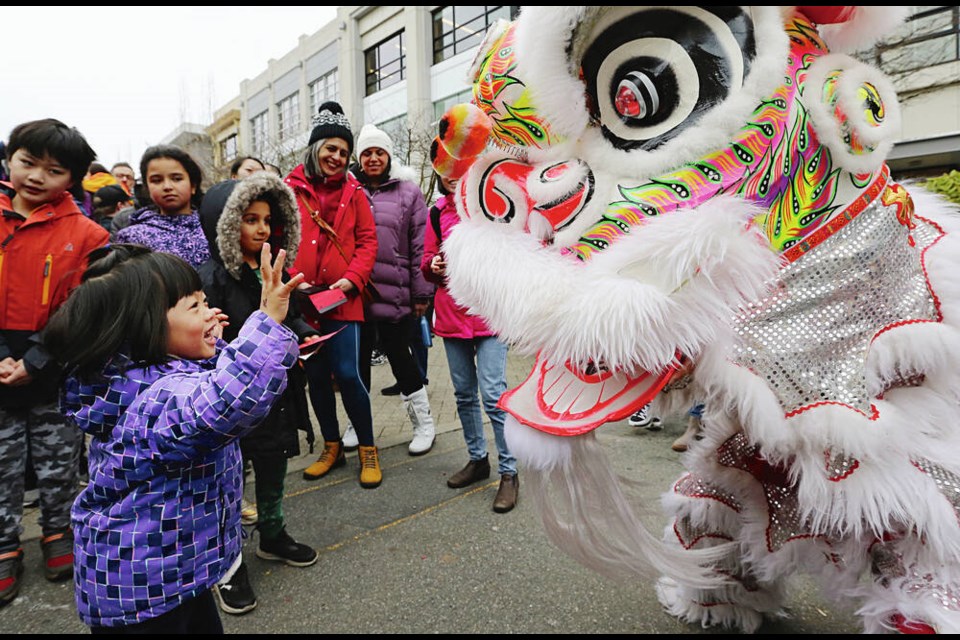People strolling in Victoria’s Chinatown took an extra moment to greet each other with “Gung Hay Fat Choy” (Happy New Year) on Saturday as the area’s Asian community celebrated the first day of the lunar year.
Saturday marked the start of two weeks of celebrations by Chinese families who traditionally set off firecrackers to scare away evil spirits, and visit family and loved ones. The festival is the largest on the Chinese lunar calendar, with the dates falling between late January and the middle of February.
“Chinese New Year is like Christmas, Thanksgiving and Easter all rolled into one,” said Daniel Low, a member of the Wong Sheung Kung Fu Club. “It’s all about food and family for two weeks.”
Parents use the occasion to purchase new clothes for their children (with red being the most popular and traditional colour). When families meet, adults give unmarried children “laisee,” a red envelope containing money.
Traditionalists have an affinity for currency that has a red hue to it. When the red two-dollar bill was in circulation, Chinese families would go to banks requesting new bills in the weeks and months preceding the new year.
This year is the Year of the Dragon in the Chinese zodiac.
Unlike Western astrology, which uses a solar calendar, the Chinese zodiac is based on both solar and lunar calendars.
Western astrology signs are named after constellations seen in the sky throughout the year. By comparison, the Chinese zodiac is based on a 12-year cycle, with a different animal representing each year.
The signs include rat, ox, tiger, rabbit, dragon, snake, horse, sheep, monkey, rooster, dog and pig. It’s said that people born under certain signs take on the characteristics of the various animals.
People born under the sign of the dragon are said to be lucky, resilient, confident, intelligent and intuitive.
People born in 1928, 1940, 1952, 1964, 1976, 1988, 2000 and 2012 also fall under the sign of the dragon.
The animals are affected by the five elements around them — metal, water, wood, fire and earth. Each year a different element is attached to an animal. This year is the Year of Wood, the most human of the elements. People who are born under this element are said to be driven, assertive and charismatic.
“Every [traditional Chinese] family wants a dragon baby,” said Charlayne Thornton-Joe, visitor experience and facilities co-ordinator of Victoria’s Chinese Canadian Museum. “It’s the most important mythological sign.”
She said that the museum, in Chinatown’s Fan Tan Alley, has a new interpretive panel for the occasion, as well as a paper dragon display at the start of the exhibit.
Events at the museum Sunday include a reading of White Jade Tiger, a book inspired by Fan Tan Alley, by its author Julie Lawson. People can check out the Chinese zodiac interpretation stand and find out what animal sign they were born under and what it says about them. And there’s a tasting table for lychee (a oriental fruit), while quantities last. Museum events are being held 11 a.m. to 5 p.m. The reading is 10:30 a.m. to 11:30 a.m.
The Wong Sheung Kung Fu Club performed at Uptown shopping centre on Saturday and will give another Lunar New Year public performance, as well as “awakening” three new lions, at 2:30 p.m. Sunday at 503 Park Place, Esquimalt.
Next Sunday, Feb. 18, the Victoria Lunar New Year Parade, presented by the Chinese Consolidated Benevolent Association, will start at the Gates of Harmonious Interest, 500-block of Fisgard Street. It features an eight-lion dance, a dragon dance by the Victoria Chinese Public School and other traditional dancers, starting 11:30 a.m.
After the parade, lion dancers will bless the museum to drive away bad luck and bring in good fortune for the New Year.
Victoria’s Chinatown is the oldest in Canada and the only one in North America relatively unchanged outwardly, with the largest intact cluster of Chinese structures dating back to the 19th century.
The area was designated a site of national and architectural significance by the Historic Sites and Monuments Board of Canada in 1995.
>>> To comment on this article, write a letter to the editor: [email protected]



